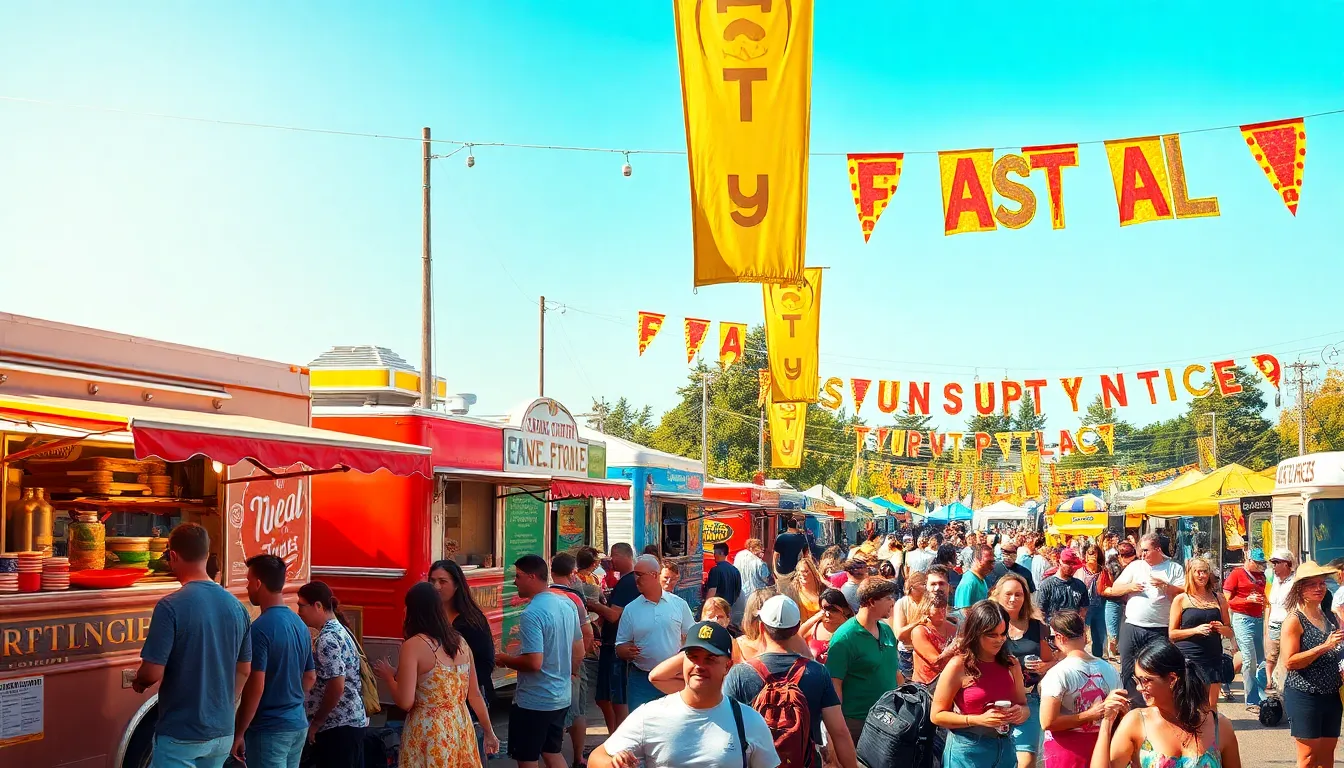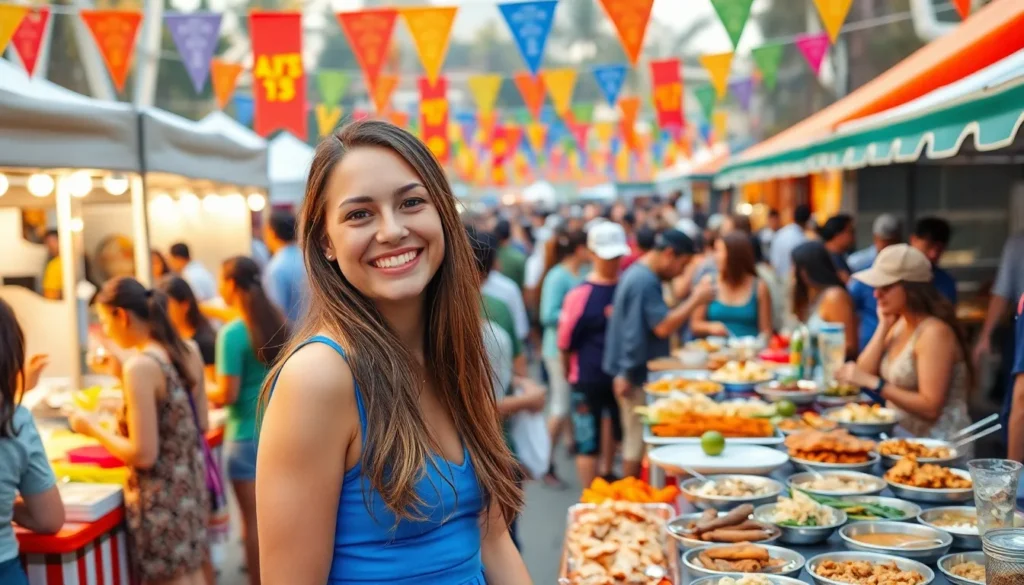Table of Contents
ToggleFood festivals have become vibrant celebrations of culture, flavor, and community. They bring together food lovers, chefs, and local producers to showcase the diverse culinary landscapes of different regions. From street food markets to gourmet tastings, these events offer something for everyone, turning casual diners into passionate foodies.
As attendees wander through stalls brimming with mouthwatering dishes, they experience not just a feast for the senses but also a chance to connect with the stories behind each dish. With the rise of social media, food festivals have gained even more popularity, drawing crowds eager to share their gastronomic adventures. Whether it’s indulging in local specialties or discovering new tastes, food festivals create unforgettable experiences that celebrate the art of cooking and the joy of eating.
Overview of Food Festivals
Food festivals showcase a vibrant blend of culture, flavor, and community. These events attract food enthusiasts, chefs, and local producers, emphasizing the diverse culinary offerings across various regions. Participants experience a rich sensory journey, with the opportunity to learn about the stories behind the dishes.
Food festivals often feature local specialties, allowing attendees to explore new tastes and culinary traditions. They promote regional ingredients, encouraging sustainability and supporting local economies. The influence of social media enhances their reach, creating buzz and drawing large crowds. Food festivals foster connections between chefs, producers, and consumers, celebrating the art of cooking and the joy of dining together.
Popular Food Festivals Around the World

Food festivals showcase regional cuisine, attracting locals and tourists alike. These events highlight culinary traditions and innovative flavors unique to each area.
Regional Highlights
- Oktoberfest, Germany
Oktoberfest in Munich celebrates Bavarian culture and cuisine. It features traditional foods like pretzels, sausages, and roasted chicken, along with a variety of beers.
- La Tomatina, Spain
La Tomatina in Buñol allows participants to throw tomatoes at each other. This festival also highlights local dishes such as paella and other tomato-based recipes.
- Gion Matsuri, Japan
Gion Matsuri in Kyoto occurs annually in July and showcases traditional Japanese cuisine. Festival-goers can enjoy street foods like yakitori, yaki dori, and sweet mochi.
- Feast Portland, USA
Feast Portland promotes the culinary scene in the Pacific Northwest. The festival features local chefs, wine makers, and a diverse array of food trucks.
Unique Food Offerings
- PoutineFest, Canada
PoutineFest in Montreal celebrates Canada’s beloved dish, poutine. Attendees can sample various toppings and styles, showcasing creativity in culinary presentations.
- Napa Valley Wine and Food Festival, USA
At the Napa Valley Wine and Food Festival, gourmet food pairs with local wines. Exclusive tastings and chef demonstrations highlight California’s culinary excellence.
- Harbin Ice and Snow Festival, China
The Harbin Ice and Snow Festival includes unique ice sculptures and winter delicacies. Traditional dishes such as hot pot and dumplings offer warmth during the cold season.
- Marrakech Food Festival, Morocco
The Marrakech Food Festival provides an immersive experience of Moroccan cuisine. Attendees enjoy tagines, couscous, and traditional sweets while indulging in vibrant spices.
The Impact of Food Festivals on Local Communities
Food festivals significantly influence local communities, enhancing economic growth and fostering cultural exchange. These events create opportunities for collaboration, innovation, and community bonding.
Economic Benefits
Food festivals generate substantial revenue for local economies. They attract tourists, with participants spending on accommodations, transportation, and meals. For example, festivals often increase sales for local restaurants and vendors, contributing to job creation. A report from the National Restaurant Association notes that food festivals can elevate sales for local businesses by 20–30% during the event. Additionally, these festivals may also stimulate investments in infrastructure and improvements in public spaces, benefiting residents long after the event concludes.
Cultural Exchange
Food festivals serve as vibrant platforms for cultural exchange, showcasing diverse culinary traditions. They encourage chefs and producers to share their heritage, promoting understanding and appreciation of different cultures. Attendees gain insights into various cooking techniques and local ingredients, fostering respect for global culinary practices. By celebrating regional specialties, food festivals connect communities, highlighting their unique stories. This exchange not only enriches local culture but also strengthens community bonds through shared experiences and flavors.
Tips for Attending Food Festivals
Attending food festivals requires some preparation to ensure a rewarding experience. Following these tips enhances enjoyment and maximizes the culinary adventure.
Planning Your Visit
- Research festivals in advance, reviewing schedules, locations, and featured cuisines. Knowledge about specific vendors or chefs adds context to the experience.
- Purchase tickets ahead of time, as many events offer discounted early bird options. This practice secures attendance and may allow for added perks.
- Check the festival layout online to identify key attractions, restroom locations, and seating areas. Familiarizing oneself with the map helps navigate the event efficiently.
- Plan dietary preferences and restrictions, as some festivals cater to specific needs. Identify available options to fully enjoy the culinary offerings.
- Set a timeline to prioritize must-try foods and events. Creating a schedule allows for covering more ground without feeling rushed.
What to Bring
- Cash and cards, as vendors often accept both forms of payment. Some may only take cash, so having a mix ensures access to all options.
- Reusable utensils and containers for sampling food. This choice supports sustainability and reduces waste generated during the festival.
- Comfortable footwear for extensive walking. Festivals often span large areas, and comfortable shoes enhance stamina throughout the day.
- A portable charger for smartphones, ensuring easy access to social media and festival apps. Documenting experiences online fosters connection with others.
- Water bottle, especially during outdoor events. Staying hydrated allows for prolonged enjoyment of sampling and activities.
Food festivals are more than just events; they’re a celebration of culture and community. They create a unique space where flavors collide and stories are shared. As attendees savor local specialties and explore diverse culinary traditions, they contribute to a vibrant exchange that enriches both the palate and the community.
These festivals not only boost local economies but also foster connections among chefs, producers, and food lovers. By embracing sustainability and promoting regional ingredients, food festivals encourage a deeper appreciation for the culinary arts. With careful preparation and an adventurous spirit, everyone can enjoy the unforgettable experiences these festivals offer. The world of food festivals awaits, inviting all to indulge in the joys of taste and togetherness.







